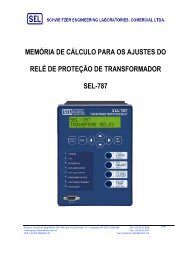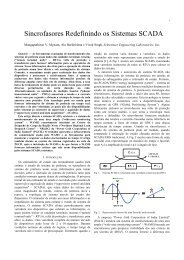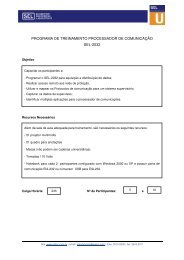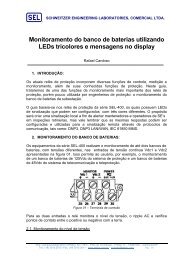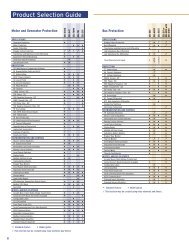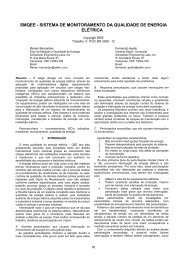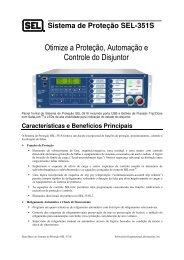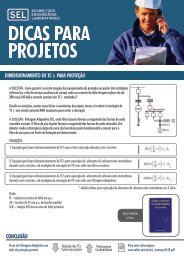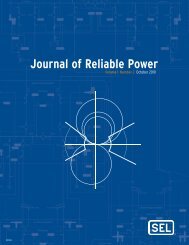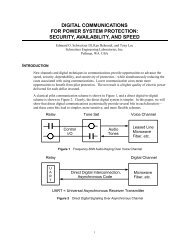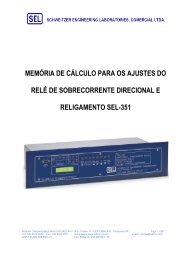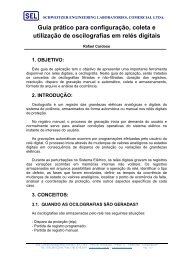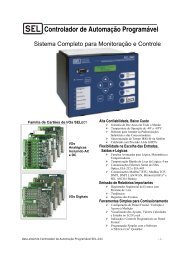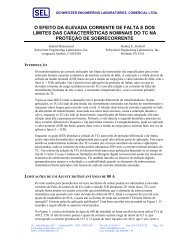Journal of Reliable Power - SEL
Journal of Reliable Power - SEL
Journal of Reliable Power - SEL
Create successful ePaper yourself
Turn your PDF publications into a flip-book with our unique Google optimized e-Paper software.
5<br />
II. QUADRILATERAL DISTANCE ELEMENTS<br />
Mho distance elements describe a natural and smooth<br />
curvature on the impedance plane. The shape is the result <strong>of</strong> a<br />
phase comparison <strong>of</strong> two quantities that yield the familiar<br />
circle on the apparent impedance plane [9]. Quadrilateral<br />
distance elements are not as straightforward. Combining<br />
distance elements has allowed designers to create all types <strong>of</strong><br />
shapes and polygonal characteristics.<br />
An impedance function with a quadrilateral characteristic<br />
requires the implementation <strong>of</strong> the following:<br />
• A directional element<br />
• A reactance element<br />
• Two left and right blinder resistance calculations<br />
Fig. 9 illustrates a typical quadrilateral element composed<br />
<strong>of</strong> three distance elements. The element that determines the<br />
impedance reach is the reactance element X. The element that<br />
determines the resistive coverage for faults is the right<br />
resistance element Rright. The element that limits the<br />
coverage for reverse flowing load is the left resistance element<br />
Rleft. A directional check keeps the unit detecting faults in the<br />
forward direction only.<br />
Fig. 9.<br />
Components <strong>of</strong> a quadrilateral distance element<br />
The setting <strong>of</strong> the reach on the line impedance angle locus<br />
is denoted by Zset in Fig. 9. It is not a setting on the X axis but<br />
is the reach on the line impedance. We will show that this<br />
setting is the pivot point <strong>of</strong> the line impedance reach. The Rset<br />
setting is the resistive <strong>of</strong>fset from the origin. A line parallel to<br />
the line impedance is shown in Fig. 9.<br />
The impedance lines in Fig. 9 are straight lines for practical<br />
purposes. The theory, however, shows that these lines are<br />
infinite radius circles [9]. The polarizing quantity for creating<br />
these large circles is the measured current at the relay location.<br />
A. Adaptive Reactance Element<br />
Several protective relaying publications report that serious<br />
overreach problems are experienced by nonadaptive reactance<br />
elements because <strong>of</strong> forward load flow and Rf [1][2][11]. If<br />
the reactance element in a quadrilateral characteristic is not<br />
designed to accommodate the situation shown in Fig. 10, an<br />
external fault with Rf may enter the operating area. The<br />
intrinsic curvature and beneficial shift <strong>of</strong> the mho circle are<br />
sufficient to overcome this problem. However, reactance lines<br />
need to be designed to accommodate this issue.<br />
Fig. 10.<br />
jX<br />
The reactance and mho elements adapt to load conditions<br />
Fig. 10 shows the desired behavior <strong>of</strong> the reactance line for<br />
forward load flow. A tilt in the shown direction is required.<br />
Several techniques have been proposed for this purpose,<br />
including a fixed characteristic tilt and the use <strong>of</strong> prefault load.<br />
Interestingly, an infinite diameter mho circle provides the<br />
same tilt as a regular mho circle, and the reactive line becomes<br />
adaptive [9]. The proper polarizing current is the negativesequence<br />
component [12]. The homogeneity <strong>of</strong> the negativesequence<br />
network and the closer proximity <strong>of</strong> the I2 angle to<br />
the fault current (If) angle makes the I2 current an ideal<br />
polarizing quantity.<br />
To obtain the desired reactance characteristic for the AG<br />
loop, the following two quantities can be compared with a<br />
90-degree phase comparator:<br />
S1 = VRA − Zset(IRA + k0 3I0)<br />
(2)<br />
( ) jT<br />
S2 = j IR2 e<br />
(3)<br />
Equations (4) and (5) define the resulting a and b vectors<br />
used to plot the reactance element characteristic [9].<br />
a = Zset<br />
(4)<br />
⎡<br />
o ⎛ IA1 IA0 Zset0 ⎞⎤<br />
− j ⎢90 − T+ ang ⎜1+ +<br />
⎟⎥<br />
⎣ ⎝ IA2 IA2 Zset ⎠⎦<br />
b = ∞ e<br />
(5)<br />
Zset0 − Zset1<br />
k0 = (6)<br />
3• Zset1<br />
where:<br />
k0 is the zero-sequence compensating factor.<br />
Zset0 is the zero-sequence impedance reach derived from<br />
k0 and Zset.<br />
R<br />
Adaptive Phase and Ground Quadrilateral Distance Elements | 69



